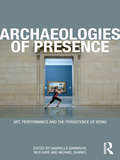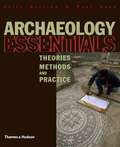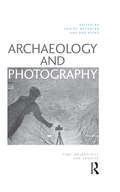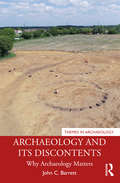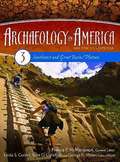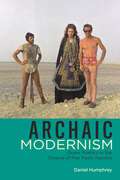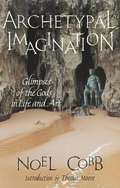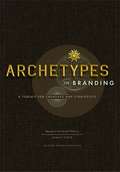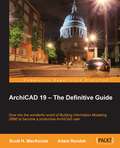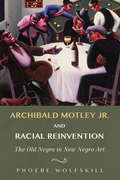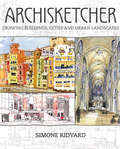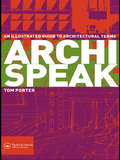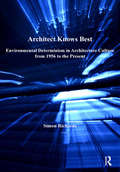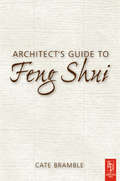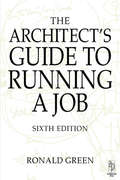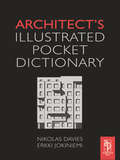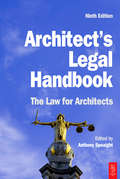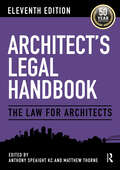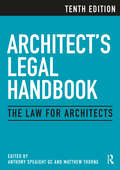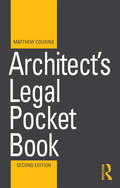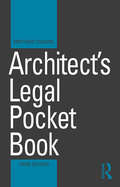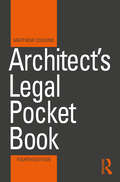- Table View
- List View
Archaeological Resource Management
by John CarmanArchaeological resource management (ARM) is the practice of recording, evaluating, preserving for future research and presenting to the public the material remains of the past. Almost all countries uphold a set of principles and laws for the preservation and professional management of archaeological remains. This book offers a critical and comparative perspective on the law and professional practices of managing archaeological remains. Beginning with a global history of ARM, John Carman provides an overview of legal and professional regulations governing ARM today. He then turns to consider the main practices involved in managing archaeological remains, namely, their identification and recording, their evaluation for 'significance', their preservation and their presentation to the public. As a whole, the book offers an overview of what ARM 'does' in the world, with implications for understanding the role of archaeology as a contemporary set of practices that determine how future generations will access material remains of the past.
Archaeologies of Presence
by Michael Shanks Gabriella Giannachi Nick KayeArchaeologies of Presence is a brilliant exploration of how the performance of presence can be understood through the relationships between performance theory and archaeological thinking. Drawing together carefully commissioned contributions by leading international scholars and artists, this radical new work poses a number of essential questions: What are the principle signifiers of theatrical presence? How is presence achieved through theatrical performance? What makes a memory come alive and live again? How is presence connected with identity? Is presence synonymous with 'being in the moment'? What is the nature of the ‘co-presence’ of audience and performer? Where does performance practice end and its documentation begin? Co-edited by performance specialists Gabriella Giannachi and Nick Kaye, and archaeologist Michael Shanks, Archaeologies of Presence represents an innovative and rewarding feat of interdisciplinary scholarship.
Archaeology Essentials: Theories, Methods and Practice
by Colin Renfrew Paul BahnThis new volume has all the authority of Colin Renfrew and Paul Bahn's groundbreaking guide to all aspects of archaeology, but it has been carefully rewritten to provide a readable and compact introduction to archaeology for those new to the field. No other book of this length can match its range of essential information and explanation. Long-established techniques are carefully explained as well as exciting new methods as the authors describe the ways in which archaeologists seek to explain and interpret the remote past of humankind.
Archaeology and Photography: Time, Objectivity and Archive
by Lesley McFADYENDoes a photograph freeze a moment of time? What does it mean to treat a photographic image as an artefact? In the visual culture of the 21st century, do new digital and social forms change the status of photography as archival or objective – or are they revealing something more fundamental about photography’s longstanding relationships with time and knowledge?Archaeology and Photography imagines a new kind of Visual Archaeology that tackles these questions. The book reassesses the central place of Photography as an archaeological method, and re-wires our cross-disciplinary conceptions of time, objectivity and archives, from the History of Art to the History of Science.Through twelve new wide-ranging and challenging studies from an emerging generation of archaeological thinkers, Archaeology and Photography introduces new approaches to historical photographs in museums and to contemporaryphotographic practice in the field. The book re-frames the relationship between Photography and Archaeology, past and present, as more than a metaphor or an analogy – but a shared vision.Archaeology and Photography calls for a change in how we think about photography and time. It argues that new archaeological accounts of duration and presence can replace older conceptions of the photograph as a snapshot orremnant received in the present. The book challenges us to imagine Photography, like Archaeology, not as a representation of the past and the reception of traces in the present but as an ongoing transformation of objectivity and archive.Archaeology and Photography will prove indispensable to students, researchers and practitioners in History, Photography, Art, Archaeology, Anthropology, Science and Technology Studies and Museum and Heritage Studies.
Archaeology and its Discontents: Why Archaeology Matters (Themes in Archaeology Series)
by John C. BarrettArchaeology and its Discontents examines the state of archaeology today and its development throughout the twentieth century, making a powerful case for new approaches. Surveying the themes of twentieth-century archaeological theory, Barrett looks at their successes, limitations, and failures. Seeing more failures and limitations than successes, he argues that archaeology has over-focused on explaining the human construction of material variability and should instead be more concerned with understanding how human diversity has been constructed. Archaeology matters, he argues, precisely because of the insights it can offer into the development of human diversity. The analysis and argument are illustrated throughout by reference to the development of the European Neolithic. Arguing both for new approaches and for the importance of archaeology as a discipline, Archaeology and its Discontents is for archaeologists at all levels, from student to professor and trainee to experienced practitioner.
Archaeology in America: An Encyclopedia, Volume 3 Southwest and Great Basin/Plateau
by Francis P. McManamon Linda S. Cordell Kent G. Lightfoot George R. MilnerThis section of Archaeology in America includes essays about archaeological sites in the Southwest region of North America. The articles in the Southwest section of Archaeology in America include eleven general essays on topics that cover ancient or historic time periods. The general essays are followed by fifty-one essays on specific archaeological sites or about archaeological sites in a particular region.
Archaeology of the Political Unconscious: Theater and Opera in East Berlin, 1967–1977 (ISSN)
by Jennifer WilliamsThis book investigates the aesthetic and political dialectics of East Berlin to argue how its theater and opera stages incited artists to act out, fuel, and resist the troubled construction of political legitimacy.This volume investigates three case studies of how leading East Berlin stages excavated fragmentary materials from Weimar dramatist Bertolt Brecht’s oeuvre and repurposed them for their post‑fascist society: Uta Birnbaum’s 1967 Man Equals Man at the Berliner Ensemble, Joachim Herz’s 1977 Rise and Fall of the City of Mahagonny at the Komische Oper, and Heiner Muller’s own productions of his trailblazing plays. In each instance, reused theatrical artifacts dialectically expressed the contradictions inherent in East German political legitimacy, at once amplifying and critiquing it. Illuminated by original archival research and translations of letters and artistic ephemera published in English for the first time, and engaging with alternative East German feminist epistemologies, this book’s critical investigation of culture and political legitimacy in the shadow of Germany’s fascist past resonates beyond the Iron Curtain into the twenty‑first century. Its final chapter examines how performative artifacts influence the process of political legitimation in more recent history, ranging from Checkpoint Charlie tourism to the January 6, 2021 US insurrection.This study will be of great interest to students and scholars in theater and performance studies, art history, musicology, German studies, anthropology, and political science.
Archaic Modernism: Queer Poetics in the Cinema of Pier Paolo Pasolini (Queer Screens)
by Daniel HumphreyIn Archaic Modernism, Daniel Humphrey offers the first book-length, English-language examination of three adaptations of Greek tragedy produced by the gay and Marxist Italian filmmaker Pier Paolo Pasolini: Oedipus Rex (1967), Medea (1969), and Notes Towards an African Orestes (1970/1973). Considering Pasolini’s own theories of a "Cinema of Poetry" alongside Jacques Derrida’s concept of écriture, as well as more recent scholarship by queer theory scholars advocating for an antirelational and antisocial subjectivity, Humphrey maintains that Pasolini’s Greek tragedy films exemplify a paradoxical sense of "archaic modernism" that is at the very heart of the filmmaker’s project. More daringly, he contends that they ultimately reveal the queer roots of Western civilization’s formative texts. Archaic Modernism is comprised of three chapters. Chapter 1 focuses on Oedipus Rex, assessing both the filmic language employed and the deeply queer mythological source material that haunts the tragedy even as it remains largely at a subtextual yet palpable level. Chapter 2 extends and deepens the concept of queer fate and queer negativity in a scene-by-scene analysis of Medea. Chapter 3 looks at the most obscure of Pasolini’s feature length films, Notes Towards an African Orestes, a film long misunderstood as an unwitting failure, but which could perhaps best be understood as a deliberate, sacrificial act on the filmmaker’s part. Considering the film as the third in an informal, maybe unconscious, trilogy, Humphrey concludes his monograph by arguing that this "trilogy of myth" can best be understood as a deconstruction, gradually more and more severe, of three of the most important origin tales of Western civilization. Archaic Modernism makes the case that these three films are as essential as those Pasolini films more often studied in the Anglophone world: Mamma Roma, The Gospel According to Matthew, Teorema, The Trilogy of Life, and Salò, and that they are of continuing, perhaps even increasing, value today. This book is of specific interest to scholars, students, and researchers of film and queer studies.
Archetypal Imagination: Glimpses of the Gods in Life and Art
by Noel CobbCobb teaches us to look at the world as a record of the soul's struggles to awaken and as the soul's poetry. <P><P>From this perspective, the real basis of the mind is poetic. Beauty, love, and creativity are as much instincts of the soul as sexuality or hunger. <P><P>Cobb shows us how artists and mystics can teach us the meaning of love, death, and beauty, if only we can awaken to their creations.
Archetypes in Branding
by Joshua C. Chen Margaret HartwellCommunication. Authenticity. Creativity. Tomorrow's brands will be defined by their interactions and relationships. Customers are demanding greater accountability from businesses. Workers are craving a deeper sense of meaning from their careers. And companies are continually seeking ways to achieve more powerful and resonant brand engagements. Archetypes in Branding: A Toolkit for Creatives and Strategists offers a practical tool for satisfying these needs. Using a highly participatory approach to brand development, and combined with a companion deck of sixty original archetype cards, this kit gives you the tools you need to: Reveal your brand's motivations, how it moves in the world, what its trigger points are and why it attracts certain customers Forge relationships with the myriad stakeholders that affect your business Empower your team to access their creativity and innovate with integrity C.G. Jung describes archetypes as "pieces of life itself-images that are integrally connected to the individual by the bridge of emotions." Applying archetypes helps bridge the gap between the cognitive and intuitive sides of the brain and between internal and external business objectives. Archetypes in Branding takes you through a fascinating exploration of the important role archetypes have played in mythology and psychology-and now in business-to resolve brand inconsistencies and enhance trust with all stakeholders.
ArchiCAD 19 – The Definitive Guide
by Scott H. Mackenzie Adam RendekThis book is for architects, architectural technicians, and construction professionals who are familiar with 2D CAD programs such as AutoCAD Lite, or have some exposure to a 3D BIM package such as Revit. No experience with ArchiCAD is required. If you want to learn the skills needed for architectural drawing production in the real world, then this book is for you.
Archibald Motley Jr. and Racial Reinvention: The Old Negro in New Negro Art
by Phoebe WolfskillAn essential African American artist of his era, Archibald Motley Jr. created paintings of black Chicago that aligned him with the revisionist aims of the New Negro Renaissance. Yet Motley's approach to constructing a New Negro--a dignified figure both accomplished and worthy of respect--reflected the challenges faced by African American artists working on the project of racial reinvention and uplift. Phoebe Wolfskill demonstrates how Motley's art embodied the tenuous nature of the Black Renaissance and the wide range of ideas that structured it. Focusing on key works in Motley's oeuvre, Wolfskill reveals the artist's complexity and the variety of influences that informed his work. Motley's paintings suggest that the racist, problematic image of the Old Negro was not a relic of the past but an influence that pervaded the Black Renaissance. Exploring Motley in relation to works by notable black and non-black contemporaries, Wolfskill reinterprets Motley's oeuvre as part of a broad effort to define American cultural identity through race, class, gender, religion, and regional affiliation.
Archisketcher: Drawing Buildings, Cities and Landscapes
by Simone Ridyard"For urban sketchers...each new city is a clean white page."There is nothing quite like the thrill of heading out on the town, sketchbook in hand, in search of a view worth capturing. Archisketcher will help you embrace the excitement of sketching on location while overcoming common challenges. You'll see that you don't need to be an architect to draw architecture confidently. Nor do you need to understand the intricate details of perspective, design or color theory. This dynamic handbook tells you just what you need to know to create sketches that work well compositionally, provide a sense of depth and scale, and--most importantly--capture the true spirit of place.Richly illustrated with urban landscapes from around the world--from skyscrapers in Asia, to picturesque English villages, to Mediterranean hill townsTwo-page spreads present various artists' interpretations of Notre Dame, the Brooklyn Bridge and other iconic landmarksFeatures ten spotlights on contemporary urban sketchers who discuss the architectural styles and features in their own neighborhoods, from Montreal to Madrid From architectural portraits to bustling streetscapes to sweeping skylines, the art of urban sketching comes alive on these pages. Whether you aspire to capture the pulse of cities afar or your own hometown, the art and ideas in this book will make your efforts more successful and enjoyable.
Archispeak: An Illustrated Guide to Architectural Terms
by Tom PorterWidely used in architectural circles in the heat of discussion, the recurrent use of particular words and terms has evolved into a language of design jargon. Commonly found in architectural literature and journalism, in critical design debate and especially in student project reviews, Archispeak can seem insular and perplexing to others and -- particularly to the new architectural student -- often incomprehensible.There is a need to translate architectural design concepts into spoken and written commentary -- each word in use embodying a precise and universally accepted architectural meaning. If we explore the vocabulary of this language we gain insight into good design practice and into collective understanding of what constitutes a refined architecture. This unique illustrated guide will help students understand the nuances of this specialized language and help them in communicating their own design ideas.
Architect Knows Best: Environmental Determinism in Architecture Culture from 1956 to the Present (Ashgate Studies In Architecture Ser.)
by Simon RichardsThe idea that buildings could be used to reform human behaviour and improve society was fundamental to the 'modernist' architecture and planning of people like Walter Gropius, Le Corbusier and José Luis Sert in the first half of the 20th century. Their proposals for functional zoning, multi-level transport, high-rise living, and machine-inspired aesthetics came under attack from the 1950s onwards, and many alternative approaches to architecture and planning emerged. It was thought that the environmental determinist strand of the discourse was killed off at this time as well. This book argues that it was not, but on the contrary, that it has deepened and diversified. Many of the most prominent architect-planners continue to design with a view to improving the behaviour of individual people and of society at large. By looking at - and interviewing - major figures and movements of recent years in Britain, Europe and America, including Léon Krier, Peter Eisenman, Andrés Duany, Jane Jacobs, Robert Venturi and Denise Scott Brown, it demonstrates the myriad ways that architect-planners seek to shape human behaviour through buildings. In doing so, the book raises awareness of this strand within the discourse and examines its different purposes and manifestations. It questions whether it is an ineradicable and beneficial part of architecture and planning, or a regrettable throwback to a more authoritarian phase, discusses why is it seldom acknowledged directly and whether it could be handled more responsibly and with greater understanding. Richards does not provide any simple solutions but in conclusion, is critical of architect-planners who abuse the rhetoric of social reform simply to leverage their attempts to secure building commissions, while being more sympathetic towards those who appear to have a sincere desire to improve society through their buildings.
Architect's Drawings
by Kendra Schank SmithThe sketch is a window into the architects mind. As creative designers, architects are interested in how other architects, particularly successful ones, think through the use of drawings to approach their work. Historically designers have sought inspiration for their own work through an insight into the minds and workings of people they often regard as geniuses. This collection of sketches aims to provide this insight. Here for the first time, a wide range of world famous architects' sketches from the Renaissance to the present day can be seen in a single volume. The sketches have been selected to represent the concepts or philosophies of the key movements in architecture in order to develop an overall picture of the role of the sketch in the development of architecture. The book illustrates the work of designers as diverse as Andrea Palladio, Erich Mendelsohn, Sir Edwin Lutyens, Gianlorenzo Bernini, Le Corbusier, Michelangelo, Alvar Aalto, Sir John Soane, Francesco Borromini, Walter Gropius, and contemporary architects Tadao Ando, Zaha Hadid and Frank Gehry to name but a few. Each chronologically placed sketch is accompanied by text providing details about the architect’s life, a look at the sketch in context, and the connection to specific buildings where appropriate. Style, media and meaning are also discussed, developing an explanation of the architect’s thinking and intentions. As creative designers themselves, architects are interested in how other architects, particularly successful ones, think and draw and approach their work. Historically designers have sought inspiration for their own work through an insight into the minds and workings of people they often regard as geniuses. This collection of sketches aims to provide this insight.Listed chronologically each sketch will be accompanied by a text which provides: A short synopsis/history of the architect's life; a look at the sketch in this context; the connection to a specific building (where appropriate); techniques of the sketch: style and media; meaning - what the sketch shows about the architect's thinking and intentions followed by a select bibliography for each section.
Architect's Guide to Feng Shui
by Cate BrambleCate Bramble has devoted her career to highlighting the differences between 'feng shui-lite' as a fashionable pursuit in contrast to the original intentions of the Chinese masters. Here she presents the authentic principles in a technical, no-nonsense pocket book specifically for architects. As clients become more demanding and the competition for projects heats up, the architect is well advised to have many strings to their bow. This practical guide includes line illustrations that present the principles of feng shui, the Chinese art or practice in which a structure or site is chosen or configured so as to harmonize with the spiritual forces that inhabit it, and their application in architecture through planning principles, services, building elements and materials, in an accessible, easy reference format. The feng shui-savvy architect can also benefit from feng shui's ability to match structures and land, and the peculiar capacity of authentic feng shui to forecast development-related concerns including cost overruns, quality issues - even worker injuries and trade disputes!The author explains feng shui from archaeological sources and evidence of practice in the east, contrasting it with what passes for feng shui in the west. She analyses the practice in terms of such concepts as western systems theory, viewshed, space syntax and the 'pattern landscape' theory of urban planning. For the first time, the Sustainable implications of feng shui design are explained with reference to the latest developments in behavioural and cognitve sciences, evolutionary biology and other western viewpoints.
Architect's Guide to Running a Job
by Ronald GreenBest practice is the concern of this book. An architect has to be an administrator as well as designer, and smooth economical administration will provide the conditions under which client relations can be constructive and good design can be acheived.The book is divided into 76 short sections covering the entire process, from preliminary enquiries to final fees, each with a small flow chart showing who is involved and when. This sixth revised edition updates the contents in line with present day practice, bearing in mind the changes in terminology, technology, environmental demands and the legislative background.Ronald Green and Professor Ross Jamieson who writes the foreword to this edition, are both examiners for Part Three.
Architect's Illustrated Pocket Dictionary
by Nikolas Davies Erkki JokiniemiThis pocket-sized Dictionary offers huge coverage for the 40,000+ people studying or working in architecture, construction or any of the built environment fields. From Abaciscus to Zophorus, the reader is able to quickly track down precisely the term they are looking for. The book is illustrated with stunning drawings that provide a visual as well as a textual definition of both key concepts and subtle differences in meaning. Compact and affordable; Davies and Jokiniemi's work is the miniature version of the Dictionary of Architecture and Building Construction. The Architect’s Illustrated Pocket Dictionary can be used on site or quickly at the desk and is suitable for all those interested in the buildings that surround us.
Architect's Legal Handbook: The Law For Architects (Architectural Press Legal Guides)
by Anthony SpeaightArchitect's Legal Handbook is the most widely used reference on the law for architects in practice, and the established leading textbook on law for architectural students. The ninth edition includes all the latest development in the law that affect an architect’s work, and comprehensive coverage of relevant UK law topics. Most significantly, the chapter on the JCT contracts has been completely revised to cover the 2005 update. Contributions by the foremost legal and architectural experts in the UK Full coverage of the JCT 2005 update New chapter on procurement Selected bibliography provides useful references to further reading Tables of Cases, Statutes and Statutory Instruments provide full referencing for cited cases Architect’s Legal Handbook is the essential legal reference work for all architects and students of architecture.
Architect's Legal Handbook: The Law for Architects
by Anthony Speaight Matthew ThorneCelebrating 50 years since it was first published, the Architect’s Legal Handbook has been the most widely used reference on the law for practicing architects, and the established textbook on law for architectural students. Since the last edition of this book in 2021, unprecedented change has occurred in the construction sector. The withdrawal of the United Kingdom from the European Union has ushered in changes to legislation in a wide range of areas. The tragic fire at Grenfell Tower in June 2017 and the deficiencies in design, construction, and regulation within the sector that were revealed as a result have given rise to major changes in the way projects are now carried out. An overhaul of the Building Regulations and the creation of a new Building Safety Regulator are only some of the ways in which the landscape has changed. This eleventh edition features all the latest developments in the law which affect an architect’s work, as well as providing comprehensive coverage of relevant UK law topics. Key highlights of this edition include: A new chapter has been added to cover the statutory framework for building safety (Chapter 9), which is complemented by a wholly updated chapter on construction regulation in England and Wales (Chapter 10). The chapter on public procurement law (Chapter 14) has also been entirely rewritten to focus on the Public Procurement Act 2023 and related regulations, following Brexit. New suites of standard contract forms have, since the last edition, been issued. These have seen substantial changes with chapters on JCT 2024 (Chapter 18) and the latest NEC4 forms (Chapter 19), together with wider updates to the chapters on FIDIC (Chapter 20) and other forms of contract (Chapter 21). A revised chapter on architects’ contracts with clients covering the RIBA Professional Services Contract 2024 (Chapter 37). A new section on novations in the chapter on the English Law of Contract (Chapter 2). The Architect’s Legal Handbook is the essential legal reference work for all architects and students of architecture.
Architect's Legal Handbook: The Law for Architects
by Anthony Speaight QC and Matthew ThorneThe Architect's Legal Handbook is the most widely used reference on the law for practicing architects and the established textbook on law for architectural students. Since the last edition of this book in 2010, the legal landscape in which architecture is practised has changed significantly: the long-standing procurement model with an architect as contract administrator has been challenged by the growing popularity of design and build contracts, contract notices in place of certificates, and novation of architect’s duties. The tenth edition features all the latest developments in the law which affect an architect's work, as well as providing comprehensive coverage of relevant UK law topics. Key highlights of this edition include: an overview of the legal environment, including contract, tort, and land law; analysis of the statutory framework, including planning law, health and safety, construction legislation, and building regulations in the post-Grenfell legal landscape; procurement and the major industry construction contract forms; building dispute resolution, including litigation, arbitration, adjudication, and mediation; key fields for the architect in practice, including architects’ registration and professional conduct, contracts with clients and collateral warranties, liability in negligence, and insurance; entirely new chapters on various standard form contracts, architects’ responsibility for the work of others, disciplinary proceedings, and data protection; tables of cases, legislation, statutes, and statutory instruments give a full overview of references cited in the text. The Architect’s Legal Handbook is the essential legal reference work for all architects and students of architecture.
Architect's Legal Pocket Book (Routledge Pocket Books)
by Matthew CousinsA little book that's big on information, the Architect's Legal Pocket Book is the definitive reference on legal issues for architects and architectural students. This handy pocket guide covers key legal principles which will help you to quickly understand the law and where to go for further information. Now in a fully updated new edition, this bestselling book covers a wide range of subjects focused on the UK including building legislation, negligence, liability, planning policy and development, listed buildings, party wall legislation, and rights of light. This edition also contains greater coverage of contracts including the RIBA contracts, dispute resolution and legal issues in professional practice. Illustrated with clear diagrams and featuring key cases, this is an invaluable source of practical information and a comprehensive guide of the current law for architects. It is a book no architect should be without.
Architect's Legal Pocket Book (Routledge Pocket Books)
by Matthew CousinsA little book that’s big on information, the Architect’s Legal Pocket Book is the definitive reference guide on legal issues for architects and architectural students. This handy pocket guide covers key legal principles which will help you to quickly understand the law and where to go for further information. Now in its third edition, this bestselling book has been fully updated throughout to provide you with the most current information available. Subjects include contract administration, building legislation, planning, listed buildings, contract law, negligence, liability and dispute resolution. This edition also contains new cases and legislation, contracts including the RIBA contract administration certificates, inspection duties, practical completion, the Hackitt review, the Report of the Independent Inquiry into the Construction of Edinburgh Schools and practical issues facing architects. Illustrated with clear diagrams and featuring key cases, this is a comprehensive guide to current law for architects and an invaluable source of information. It is a book no architect should be without.
Architect's Legal Pocket Book (Routledge Pocket Books)
by Matthew CousinsA little book that is big on information, the Architect’s Legal Pocket Book is the definitive reference guide on legal issues for architects and architectural students. This handy pocket guide covers key legal principles which will help you to quickly understand the law and where to go for further information.Now in its fourth edition, this bestselling book has been fully updated throughout to provide you with the most current information available. Subjects include contract administration, building legislation, planning, listed buildings, contract law, negligence, liability and dispute resolution. This edition also contains new cases and legislation, building safety, contracts, inspection duties, practical completion and practical issues facing architects.Illustrated with clear diagrams and featuring key cases, this is a comprehensive guide to current law for architects and an invaluable source of information. It is a book no architect should be without.

